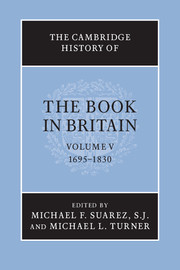Book contents
- Frontmatter
- Introduction
- PART I THE QUANTITY AND NATURE OF PRINTED MATTER
- PART II ECONOMIC, LEGAL AND CULTURAL CONTEXTS
- PART III THE TECHNOLOGIES AND AESTHETICS OF BOOK PRODUCTION
- 7 The technologies of printing
- 8 The industrialization of the paper trade
- 9 A year’s work in the London printing house of the Bowyers
- 10 Book illustration and the world of prints
- 11 The morphology of the page
- 12 Bookbinding in the eighteenth century
- PART IV THE BOOK TRADE AND ITS MARKETS
- V BOOKS AND THEIR READERS
- Abbreviations used in bibliography
- Bibliography
- Index
- Frontispiece
- Plate section
- References
9 - A year’s work in the London printing house of the Bowyers
from PART III - THE TECHNOLOGIES AND AESTHETICS OF BOOK PRODUCTION
Published online by Cambridge University Press: 28 September 2010
- Frontmatter
- Introduction
- PART I THE QUANTITY AND NATURE OF PRINTED MATTER
- PART II ECONOMIC, LEGAL AND CULTURAL CONTEXTS
- PART III THE TECHNOLOGIES AND AESTHETICS OF BOOK PRODUCTION
- 7 The technologies of printing
- 8 The industrialization of the paper trade
- 9 A year’s work in the London printing house of the Bowyers
- 10 Book illustration and the world of prints
- 11 The morphology of the page
- 12 Bookbinding in the eighteenth century
- PART IV THE BOOK TRADE AND ITS MARKETS
- V BOOKS AND THEIR READERS
- Abbreviations used in bibliography
- Bibliography
- Index
- Frontispiece
- Plate section
- References
Summary
Facing the New Year
The London printers William Bowyer, father and son, entered the year 1731 with justifiable confidence. The elder Bowyer had been in business since 1699, his skill and integrity securing valuable customers. Chief among these were the London booksellers, the wholesaling and retailing entrepreneurs who together virtually monopolized the British book trade. The younger Bowyer was growing into a considerable printer in his own right. After studying for two years at St John’s College, Cambridge, for the purpose of mastering the learned languages, he joined his father in 1722 as corrector to the press, continuing in this role to the end of his life in 1777. The firm’s heightened ability to deal with learned texts brought further commissions, notably from scholars publishing by subscription. The younger man was also branching out in new directions. In 1728 he had acquired the first of many copyrights, generally of shorter pieces, which he could print and sell without blatantly competing with the booksellers. More remarkably, in 1730 he obtained the valuable right to print the Votes of the House of Commons, then the only publicly available day-to-day record of doings of the House. Other parliamentary printing was expected. Perhaps best of all, young William’s four-month-old son and heir was thriving.
The Bowyers’ location in Temple Lane, White Friars, just off Fleet Street towards the more fashionable West End, was conveniently close to major bookseller customers such as the Lintots. Nearby in the Temple were members of the legal fraternity who brought profitable work. The commercial life of the city was all around them. As members of the Stationers’ Company, the Bowyers were in regular touch with other book-trade members, binders, booksellers, stationers as well as other printers.
- Type
- Chapter
- Information
- The Cambridge History of the Book in Britain , pp. 218 - 229Publisher: Cambridge University PressPrint publication year: 2009



